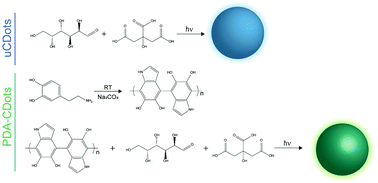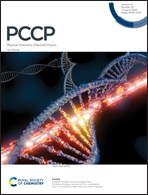Effects of polydopamine-passivation on the optical properties of carbon dots and its potential use in vivo†
Abstract
Passivation of carbon dots via heteroatom doping has been shown to enhance their optical properties and tune their fluorescence signature. Additionally, the incorporation of polymeric precursors in carbon dot synthesis has gained considerable interest with benefits to biological applications namely bioimaging, drug delivery and sensing, among others. In order to combine the desirable attributes of both, fluorescence enhancement and increased biocompatibility, polymers composed of high aromaticity and nitrogen content can be used as efficient carbon dot passivating agents. Here, the synthesis of fluorescent polymer-passivated carbon dots was developed through a microwave-assisted pyrolysis reaction of galactose, citric acid and polydopamine. Passivation of the dots with polydopamine induces a 90 nm red-shift in the fluorescence maxima from 420 to 510 nm. Moreover, passivation results in excitation-independent fluorescence and a 3.5-fold increase in fluorescence quantum yield, which increases from 1.3 to 4.6%. The application of the carbon dots as imaging probes was investigated in in vitro and in vivo model systems. Cytotoxicity studies in J774 and CHO-K1 cell lines revealed reduced cell toxicity for the polydopamine-passivated carbon dots in comparison to their unpassivated counterpart. In BALB/c mice, biodistribution studies demonstrated that regardless of surface passivation, the dots predominantly remained in the circulatory system 90 minutes post inoculation suggesting their potential use for cardiovascular therapies.

- This article is part of the themed collection: 2020 PCCP HOT Articles


 Please wait while we load your content...
Please wait while we load your content...